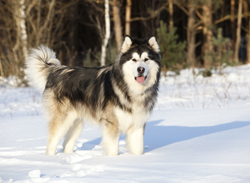The Alaskan Malamute is a highly intelligent and very strong breed with a deep chest, muscular body, and broad head. The ears are triangular and the coat is thick and coarse with a wooly undercoat. Malamutes have a plumed tail that carries over their back and range in color from sable to red or light gray to black. The breed is known for its distinguishing face markings that include a cap on the head and a mask or bar over the face. Sometimes, the face is all white. Adults are 23 to 25 inches tall at the shoulder and weigh 70 to 100 pounds.
The breed is known for its distinguishing face markings that include a cap on the head and a mask or bar over the face.
This friendly and intelligent breed is large and strong and has been used historically for carrying large loads. Even though it works primarily as a sled dog, it is generally not used for racing. Malamutes are playful and athletic and enjoy backpacking, swimming, jogging, and other activities with their human companions. With regular exercise and routine vet care, Alaskan Malamutes live up to 15 years.
Canine genome studies show the Alaskan Malamute is the largest and oldest of Arctic sled dogs and one of most ancient breeds in existence.
Malamutes are intelligent, dignified, affectionate, and friendly, which makes them ideal companions for people of all ages. They are also loyal and devoted. Although the breed is decent with children, these dogs do not get along very well with cats.
Alaskan Malamutes are very curious and moderately vocal. They'll sing to you or along with the radio, which can be endearing, but the breed is also known to howl with sirens or when left alone in the backyard. This can quickly become tiresome for caretakers and neighbors. Lack of attention also increases this breed's tendency to become frustrated and destructive. Malamutes are not an ideal choice for homes with cats or for households where human companions are away for long periods.
The breed requires an outlet for excess energy and is known for having some temperament issues. Obtain your dog from an experienced and reputable breeder who has administered temperament tests. Better yet, adopt from a rescue that has evaluated the Malamute for temperament problems and can confirm compatibility with your household.
The Alaskan Malamute is an American breed named after the Mahlemuts, a native Inuit tribe who settled in Alaska. The breed has always been used for heavy freighting, but they also helped hunters find polar bears and other animals for food.
Malamutes became even more important during the Alaska Gold Rush in 1896. Miners paid extremely high prices for sleds with capable dog teams, and Malamutes proved to be some of the best of the best. Unfortunately, greed led to the crossing of Malamutes with other breeds to increase their size and speed, but the Spitz genes were too strong to be overcome. It did not take long for the Malamutes to revert to type.
Alaskan Malamutes are cousins to the Samoyed, the American Eskimo dog, and the Siberian Husky. This explains the similarities of the breeds.
The American Kennel Club officially recognized the Alaskan Malamute in 1935.
Malamutes are highly intelligent and learn quickly, but the breed can be strong-willed and difficult to train. Training must begin early in life for any chance of success.
Without training, the breed can be destructive, tearing up furniture, eating car seats, digging up yards, and engaging in other negative behaviors. Alaskan Malamutes also tend to bark a lot, dig, and jump fences. Additionally, they are known for overeating and will devour a dangerous amount of food if left unsupervised. Early training combined with plenty of physical activity helps keep these negative behaviors in check.
Malamutes must be kept on a leash or they'll be off roaming for days, chasing (and possibly harming) neighborhood cats and making friends and enemies of neighborhood dogs. For this reason, all Alaskan Malamutes should be microchipped and wear identification tags at all times.
The Alaskan Malamute's double coat is thick and coarse but requires little maintenance. The coat needs brushing several times each week to distribute skin oils and remove dead, loose hair. During the summer, grooming may need to be more frequent and shedding can become a problem. In fact, Malamutes have been known to cover an entire couch with hair in less than an hour.
The breed does not generally require bathing more than a few times each year, and trimming is necessary only for comfort. Alaskan Malamutes are not suited to hot climates and may become overheated when exercising vigorously in hot temperatures.
Trim the nails one per month or as needed, and brush the teeth every day, if possible. Check the breed's ears weekly and clean with a gentle, pH-balanced cleanser. Redness, dirt, or a bad odor are signs of an ear infection and require professional evaluation.
The Alaskan Malamute is an American breed named after the Mahlemuts, a native Inuit tribe who settled in Alaska. The breed has always been used for heavy freighting, but they also helped hunters find polar bears and other animals for food.
Malamutes became even more important during the Alaska Gold Rush in 1896. Miners paid extremely high prices for sleds with capable dog teams, and Malamutes proved to be some of the best of the best. Unfortunately, greed led to the crossing of Malamutes with other breeds to increase their size and speed, but the Spitz genes were too strong to be overcome. It did not take long for the Malamutes to revert to type.
Alaskan Malamutes are cousins to the Samoyed, the American Eskimo dog, and the Siberian Husky. This explains the similarities of the breeds.
The American Kennel Club officially recognized the Alaskan Malamute breed in 1935.

